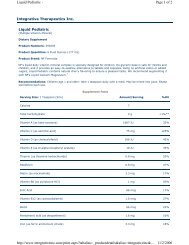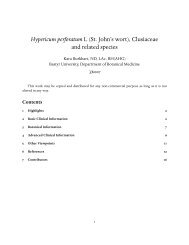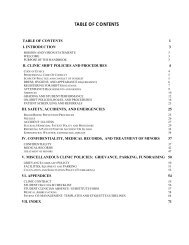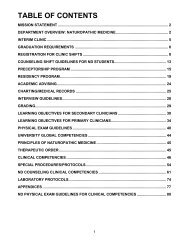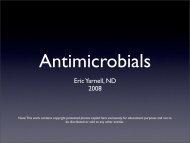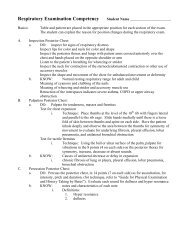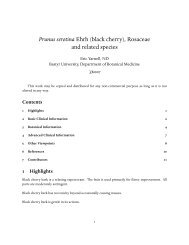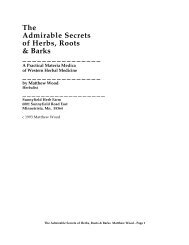Cinchona officinalis L (Peruvian bark), Rubiaceae ... - AaronsWorld
Cinchona officinalis L (Peruvian bark), Rubiaceae ... - AaronsWorld
Cinchona officinalis L (Peruvian bark), Rubiaceae ... - AaronsWorld
Create successful ePaper yourself
Turn your PDF publications into a flip-book with our unique Google optimized e-Paper software.
<strong>Cinchona</strong> <strong>officinalis</strong> L (<strong>Peruvian</strong> <strong>bark</strong>), <strong>Rubiaceae</strong><br />
and related species<br />
Eric Yarnell, ND<br />
Bastyr University, Department of Botanical Medicine<br />
c2007<br />
This work may be copied and distributed for any non-commercial purpose as long as it is not<br />
altered in any way.<br />
Contents<br />
1 Highlights 1<br />
2 Basic Clinical Information 2<br />
3 Botanical Information 7<br />
4 Advanced Clinical Information 8<br />
5 Other Viewpoints 10<br />
6 References 14<br />
7 Contributors 15<br />
1 Highlights<br />
<strong>Peruvian</strong> <strong>bark</strong> is one of the most important herbal medicines in the history of the world.<br />
Quinine, an alkaloid found in <strong>Peruvian</strong> <strong>bark</strong>, was one of the first pharmaceutical drugs, used to treat<br />
malaria patients.<br />
<strong>Peruvian</strong> <strong>bark</strong> contains multiple alkaloids that are active against malaria and other parasites.<br />
<strong>Peruvian</strong> <strong>bark</strong> is a bitter digestive stimulant.<br />
1
Figure 1: One of the original samples of C. succirubra <strong>bark</strong> sent back to England in 1861 by Richard<br />
Spruce for the Royal Kew Botanical Gardens, one of the first Europeans to successfully steal cinchona<br />
from its native habitat. His samples were ultimately the source of British plantations in India.<br />
<strong>Peruvian</strong> <strong>bark</strong> in usual doses is without adverse effects. Excessive doses cause cinchonism.<br />
2 Basic Clinical Information<br />
2.1 Part Used<br />
Dried <strong>bark</strong><br />
2.2 Taste<br />
Extremely bitter<br />
2.3 Principal Actions<br />
¯ Antiparasitic<br />
2
¯ Antimicrobial<br />
¯ Bitter digestive stimulant<br />
2.4 Major Organ System Affinities<br />
Gastrointestinal tract<br />
2.5 Major Indications<br />
¯ Dyspepsia<br />
¯ Malaria, treatment of, all types<br />
¯ Gastrointestinal parasitic infections<br />
<strong>Cinchona</strong>, its total alkaloids, and quinine are all useful for rapid destruction of the blood form<br />
(schizont) of malaria, which leads to rapid reduction in fever. Quinine was historically used to prevent<br />
malaria, but it is not the most effective agent for this. Quinine or cinchona alone are not sufficient to<br />
completely eradicate malaria from someone’s body.<br />
Numerous clinical trials have demonstrated that a combination of three or four cinchona alkaloids<br />
is either equally or more effective than quinine by itself for malaria (Borris and Schaeffer 1992; Bunnag,<br />
et al. 1989). Quinine and other alkaloids in cinchona are effective against the asexual blood form<br />
(schizonts) of all four human malaria parasites (P. falciparum, P. malariae, P. ovale,andP. vivax), and<br />
thus can be used to treat infection with any of these. Presently it is reserved for treatment of patients<br />
with drug-resistant falciparum, cerebral malaria. It is also effective against the gametocyte forms of P.<br />
malariae and P. vivax. It is unclear if cinchona or quinine are effective at preventing malaria–they are<br />
historically reported to have some efficacy in this regard but they do not appear to kill sporozoites<br />
(malaria forms injected by mosquitoes) in vitro.<br />
<strong>Cinchona</strong> and its alkaloids have shown other antibacterial effects, notably in a recent trial by inhibiting<br />
Salmonella typhimurium and Shigella flexneri from invading human colonic epithelial cells (Wolf,<br />
et al. 2005). A similar anti-invasion property was observed with pathogens such as Staphylococcus aureus<br />
and Enterobacter agglomerans (Wolf, et al. 2006). Quinine sulfate has anti-HSV-1 cell invasion and<br />
multiplications effects in vitro (Wolf, et al. 2003).<br />
2.6 Major Constituents<br />
Quinoline alkaloids<br />
2.7 Energetics<br />
2.8 Preparations and Dose<br />
Tincture: 1:3-1:5, 45% ethanol, assuming alkaline menstruum (30% ethanol and 10% vinegar can be<br />
used alternately)<br />
Tincture Doses<br />
3
R<br />
HO<br />
H<br />
9<br />
N<br />
Figure 2: Quinine, R = OCH3; Cinchonidine, R = H<br />
R<br />
HO<br />
H<br />
N<br />
9<br />
Figure 3: Quinidine, R = OCH3; Cinchonine, R = H<br />
4<br />
H<br />
H<br />
8<br />
8<br />
N<br />
N<br />
H<br />
H
Acute malaria, adult: 0.5-1 ml (possibly higher) every 2-3 h, adjusted for body size<br />
Chronic GI upset, adult: 0.5-1 ml three times per day in water before meals<br />
Child: as adult but adjusted for body size<br />
Elder: as adult<br />
Decoction: 1 g <strong>bark</strong> containing 5-6% quinine in 250 ml water simmered for 10 min, yielding approximately<br />
5-6 mg quinine per cup (more if the water is acidic). 1 cup three times per day before meals for<br />
dyspepsia in adults.<br />
Quinine sulfate by mouth for acute, mild malaria: 10 mg/kg body weight every 8 h in adults, usually<br />
combined with 100 mg doxycycline once daily, for 7 d. This dose will usually lead to development<br />
of cinchonism after 2-3 d (the dose threshold for which is approximately 2 g in a day). The dose can<br />
be lowered after 3-4 days, if asexual parasitemia has been eliminated, which will relieve cinchonism<br />
symptoms (Vieira and Midio 2001). Generally this is only used for severe, drug-resistant P. falciparum<br />
infection today.<br />
Totaquine: combination of quinine, quinidine, cinchonine, and cinchonidine, containing 7-20% quinine.<br />
Developed by Health Organisation of the League of Nations as substitute for quinine, introduced<br />
in 1934. Dose 300-600 mg (5-10 grains) three times per day. This does not appear to be available<br />
anymore for unknown reasons.<br />
Quinine dihydrochloride intravenous, for severe malaria: 20 mg/kg body weight in 5% dextrose or<br />
normal saline as a once-only 4 h infusion followed, 4 h later, by quinine dihydrochloride 10 mg/kg<br />
body weight infused over 4 h every 8 h. Generally this is only used for severe P. falciparum infection not<br />
treatable by other drugs. The loading dose should be halved for patients who have received quinine,<br />
quinidine, or mefloquine in the prior 24 h. The maintenance dose should be reduced in patients with<br />
renal impairment.<br />
Quinine can be given intramuscularly at the same dose as for IV, with the doses divided in half and<br />
injected one into each anterior thigh.<br />
2.9 Adverse Effects<br />
¯ Contact dermatitis (principally in workers who made cinchona products)<br />
¯ Nausea, transitory<br />
¯ QT prolongation, torsades de pointes<br />
¯ Hypoglycemia (quinine induces insulin secretion)<br />
QT prolongation is primarily an effect of non-quinine alkaloids, and it can be sufficiently serious<br />
to cause acute ventricular fibrillation and sudden cardiac death. It is not seen with use of whole plant<br />
extracts as a bitter, only with higher doses for attacking malaria.<br />
5
2.10 Contraindications<br />
These are largely derived from experience with higher doses of isolated quinine, so they may not be<br />
relevant to the whole herb. But conservativism is required due to the serious nature of the potential<br />
negative results.<br />
¯ Allergy to the herb<br />
¯ Ventricular arrhythmias<br />
¯ Glucose-6-phosphate dehydrogenase deficiency (high risk for hemolysis)<br />
¯ Optic neuritis (may aggravate)<br />
¯ Tinnitus (may aggravate)<br />
¯ History of blackwater fever<br />
¯ Thrombocytopenia purpura<br />
¯ Pregnancy, with great caution (fetal toxicity, primarily auditory nerve damage, may occur)<br />
¯ Lactation (does distribute to breast milk)<br />
¯ Mytasthenia gravis (may aggravate)<br />
¯ Congestive heart failure (negatively inotropic)<br />
2.11 Overdose<br />
Cinchonism<br />
¯ tinnitus<br />
¯ high-tone hearing loss<br />
¯ nausea<br />
¯ dysphoria<br />
Dose threshold: roughly 2 g daily (up to 8 g for many people) of quinine for an average size adult.<br />
Treatment: induce emesis or use gastric lavage. Maintain normal blood pressure and renal function.<br />
Urinary acidification may help with excretion but not if hemoglobinuria is present. Quinine is readily<br />
dialyzable. Hypersensitivity reactions may require epinephrine, corticosteroids, or antihistamines.<br />
Hemolytic-uremic syndrome has been known to occur in patients taking quinine for leg cramps.<br />
This appears to be due to anti-quinine antibodies cross-reacting with red blood cells. Treatment is<br />
by plasmapharesis. Incidence of this complication has not been documented to occur with use of<br />
low-doses of whole herb extracts as a bitter.<br />
Hypersensitivity reactions, manifesting as urticaria, fever, tinnitus, dyspena, asthma, hematuria,<br />
or visual disturbances, are indications for immediate discontinuation of treatment.<br />
2.12 Incompatibilities<br />
Salicylates do not mix with quinine. Tannins will precipitate the alkaloids.<br />
6
2.13 Drug Interactions<br />
Quinine and quinindine have numerous drug interactions, of questionable relevance to use of the<br />
whole herb.<br />
Aluminum antacids interfere with quinine absorption. Cimetidine appears to decrease quinine’s<br />
clearance. Rifamycins and terfenadine increase hepatic quinine clearance.<br />
Quinine administered with mefloquine can cause arrhythmias, cardiac arrest, and seizure. There<br />
is also increased risk of arrhythmias in patients taking quinine with amiodarone, cisapride, pimozide,<br />
and halofantrine.<br />
Quinine inhibits vitamin K-dependent clotting factor synthesis enzymes, and thus may have synergistic<br />
anticoagulant effects with warfarin.<br />
Quinine can increase serum concentrations of digoxin.<br />
3 Botanical Information<br />
3.1 Common Names<br />
English Common Names: cinchona, quinine <strong>bark</strong>, kinakinda, <strong>Peruvian</strong> <strong>bark</strong>, Jesuit <strong>bark</strong>, calisaya<br />
<strong>bark</strong>, fever tree<br />
Quinine is derived from a Native South American term quina meaning <strong>bark</strong>.<br />
<strong>Cinchona</strong> is named after the Spanish Countess Chinchón, wife of viceroy of Peru supposedly cured<br />
from her fever by the <strong>bark</strong> in 1638.<br />
3.2 Botanical Description<br />
Tropical evergreen trees and shrubs, with large, entire, opposite leaves, stipules, and white or pink<br />
fragrant, actinomorphic, bisexual flowers arranged in cymose inflorescences. The most important<br />
and useful species are <strong>Cinchona</strong> <strong>officinalis</strong>, C. calisaya, C. pubescens (also known as C. succirubra), and C.<br />
ledgeriana.<br />
3.3 Interchangeability of Species<br />
Latin name common name Alkaloid content<br />
<strong>Cinchona</strong> ledgeriana Ledger’s cinchona 5-14%<br />
<strong>Cinchona</strong> succirubra red cinchona 6-16%<br />
<strong>Cinchona</strong> calisaya yellow cinchona 3-7%<br />
<strong>Cinchona</strong> <strong>officinalis</strong> Jesuit <strong>bark</strong> 5-8%<br />
3.4 Native Habitat and Current Range<br />
Tropical rainforests of Colombia, Ecuador, Peru, and Bolivia. Medicinal species have also been established<br />
in large plantations in India, Indonesia and the Democratic Republic of the Congo (formerly<br />
Zaire). C. succirubra is an invasive weed in Hawaii and the Galapagos Islands.<br />
7
3.5 Ecological Status<br />
Moderately threatened by logging and harvesting for medicine, though medicinal harvesting has been<br />
greatly reduced by availability of cultivated stock.<br />
3.6 Cultivation<br />
Extremely complex and difficult, but now widely established in India, Indonesia and Zaire.<br />
3.7 Wildcrafting<br />
Unclear to what extent this is still practiced due to large-scale cultivated supplies.<br />
4 Advanced Clinical Information<br />
4.1 Additional Actions<br />
¯ Schizontocidal against Plasmodium spp, useful for treatment and suppression.<br />
¯ Anti-ameba (Borris and Schaeffer 1992)<br />
¯ Inhibition of muldrug resistance pump<br />
¯ Negative inotropic<br />
¯ Insulin secratagogue<br />
<strong>Cinchona</strong> alkaloids act primarily as blood schizonticides. Schizonts are the form of malaria that<br />
exist in red blood cells before giving rise to merozoites, which reinvade red blood cells and split into<br />
sexual forms that penetrate into mosquitoes. Quinine also kills these sexual forms (gametocytes)<br />
for the P. malariae and P. vivax forms. Though quinine and related alkaloids may have some effect<br />
against sporozoites that come out of mosquitoes and actually start a malaria infection, they are not<br />
well-established for preventing malaria, though historical reports suggest they might be protective.<br />
Quinine and related alkaloids do not appear to affect the hynozoites that persist in the liver or any<br />
exoerythrocytic forms of malaria, and thus cannot completely eradicate (cause a so-called radical cure)<br />
malaria on their own in patient infected with P. ovale or P. vivax, which have exoerythrocytic forms.<br />
4.2 Additional Indications<br />
¯ Leg cramps<br />
¯ Babesiosis<br />
¯ Amebiasis<br />
¯ Cancer chemotherapy resistance reversal<br />
Mixed results in controlled clinical trials led to FDA revoking the over-the-counter status for quinine<br />
used to treat leg cramps in 1995 (Man-Son-Hing and Wells 1995).<br />
In a phase I trial, intravenous cinchonine appeared to reverse multidrug resistance in patients with<br />
lymphoproliferative syndromes treated with chemotherapy, but there was concern about potential for<br />
8
arrhythmias, as QT prolongation was seen frequently (Solary, et al. 2000). The purported mechanism<br />
of action is inhibition of the MDR pump in cancer cells.<br />
4.3 Constituents<br />
¯ Quinine<br />
¯ Quinidine<br />
¯ Cinchonine<br />
¯ Cinchonidine<br />
4.4 Pharmacokinetics<br />
Quinine is rapidly and about 80% absorbed orally, even in patients with severe diarrhea. It distributes<br />
widely throughout the body. Quinine is 70-80% protein-bound in the blood (this rises above 90% in<br />
patients with cerebral malaria, as well as in children and pregnant women). The elimination half-life<br />
from plasma is 8-21 h in patients with malaria and shorter (7-12 h) in healthy adults. The elimination<br />
half-lives in children are about half those in adults.<br />
All alkaloids in <strong>Cinchona</strong> undergo hepatic metabolism primarily. Metabolites, mostly hydroxylated<br />
forms, are excreted primarily by the kidneys. Alkaline urine doubles the excretion rate for quinine<br />
compared to alkaline urine.<br />
Quinine does enter breast milk.<br />
4.5 Classic Formulations<br />
King’s American Dispensatory<br />
Tinctura <strong>Cinchona</strong>e Composita (U. S. P.)—Compound Tincture of <strong>Cinchona</strong>. SYNONYMS: Compound<br />
tincture of <strong>Peruvian</strong> <strong>bark</strong>, Huxham’s tincture of <strong>bark</strong>.<br />
¯ Red cinchona, 100 g<br />
¯ Bitter orange peel, 80 g<br />
¯ Serpentaria, 20 g<br />
¯ Glycerin, 75 ml<br />
¯ Ethanol 100%, 1,000 ml<br />
¯ Water, 1,000 ml<br />
Mix the glycerin with 850 ml ehtanol and 75 ml water. Mix and powder the herbs (to number 60<br />
fineness). Moisten the powder with 200 ml menstruum and macerate for 24 h in a percolator cone.<br />
Slowly percolate, adding more menstruum mixed in the same proportions as above, until 1,000 ml of<br />
tincture is prepared. Indication: bitter stomachic, 2-3 fluid drams dose.<br />
Related Tinctures.—TINCTURA CINCHONAE COMPOSITA, Compound tincture of <strong>Peruvian</strong><br />
<strong>bark</strong>. The following is the old London formula modified by Prof. King: ”Take of calisaya <strong>bark</strong>, in<br />
fine powder, 4 ounces; bitter orange peel, 3 ounces; Virginia snakeroot, in moderately fine powder,<br />
6 drachms; saffron, in coarse powder, 2 drachms; cochineal, in fine powder, 1 drachm; good diluted<br />
alcohol, 20 fluid ounces, or a sufficient quantity”(Lond.). Form it into a tincture by maceration or<br />
9
percolation, as explained under Tincturae, and make 20 fluid ounces of tincture. This tincture is<br />
generally known as Huxham’s tincture of <strong>bark</strong>. Prof. King preferred brandy as the menstruum.<br />
TINCTURA ANTIPERIODICA (N. F.), Antiperiodic tincture, Warburg’s tincture.—I. Without<br />
aloes. Rhubarb, thirty-six grammes (36 Gm.) [1 oz. av., 118 grs.]; angelica seed, thirty-six grammes<br />
(36 Gm.) [1 oz. av., 118 grs]; elecampane, eighteen grammes (18 Gm.) [278 grs.]; saffron, eighteen<br />
grammes (18 Gm.) [278 grs.]; fennel, eighteen grammes (18 Gm.) [278 grs.]; gentian, nine grammes<br />
(9 Gm.) [139 grs.]; zedoary root, nine grammes (9 Gm.) [139 grs.]; cubeb, nine grammes (9 Gm.)<br />
[139 grs.]; myrrh, nine grammes (9 Gm.) [139 grs.]; white agaric, nine grammes (9 Gm.) [139 grs.];<br />
camphor, nine grammes (9 Gm.) [139 grs.]; quinine sulphate, one hundred grammes (100 Gm.) [3 ozs.<br />
av., 231 grs.]; diluted alcohol (U. S. P.), a sufficient quantity to make five thousand cubic centimeters<br />
(5000 Cc.) [169 fl, 33]. Reduce the fibrous vegetable drugs to a coarse (No. 20) powder, mix this with<br />
the myrrh and camphor, previously powdered, and digest the whole, during 12 hours, in a suitable,<br />
well-covered vessel, with forty-two hundred and fifty cubic centimeters (4250 Cc.) [143 fl, 140] of diluted<br />
alcohol, on a water-bath, avoiding, as much as possible, any loss of alcohol by evaporation. Then<br />
strain off the liquid with pressure, dissolve the quinine sulphate in the strained liquid, with a gentle<br />
heat, if necessary, filter, and pass enough diluted alcohol, first through the strainer and then through<br />
the filter to make the product measure five thousand cubic centimeters (5000 Cc.) [169 fl, 33]. Each<br />
fluid ounce contains 10 grains of quinine sulphate. Note.—This preparation, made without aloes, is<br />
intended to serve as a stock tincture, from which the regular ’Warburg’s Tincture’ is to be made, when<br />
required. ’Warburg’s Tincture without Aloes’ is also often prescribed or asked for, and in this case the<br />
above preparation is to be dispensed. The original formula directed by Dr. Warburg, contained the<br />
old Confectio Damocratis as one of the ingredients. The latter is a very complex preparation, many<br />
of the constituents being unobtainable at the present day. It has, therefore, been omitted. II. With<br />
aloes.—Extract of aloes (U. S. P.), seventeen and one-half grammes (17.5 Gm.) [270 grs.]; antiperiodic<br />
tincture, without aloes, one thousand cubic centimeters (1000 Cc.) [33 fl, 391]. Dissolve the extract<br />
in the tincture. Note.—When ’Warburg’s Tincture, without any further specification, is ordered, this<br />
preparation (containing aloes) is to be dispensed”—(Nat. Form.).<br />
5 Other Viewpoints<br />
5.1 Discussions in Historical Texts<br />
A Modern Herbal by M. Grieve<br />
<strong>Peruvian</strong> <strong>bark</strong> was introduced to Europe in 1640, but the plant producing it was not known to botanists<br />
till 1737; a few years later it was renamed <strong>Cinchona</strong> after the Countess of Chinchon, who first made the<br />
<strong>bark</strong> known in Europe for its medicinal qualities. The history of <strong>Cinchona</strong> and its many vicissitudes<br />
affords a striking illustration of the importance of Government aid in establishing such an industry. It<br />
was known and used by the Jesuits very early in its history, but was first advertized for sale in England<br />
by James Thompson in 1658, and was made official in the London Pharmacopoeia of 1677.<br />
10
A Manual of Organic Materia Medica and Pharmacognosy.<br />
by Lucius E. Sayre, B.S. Ph. M., 1917.<br />
532. <strong>Cinchona</strong>.<strong>Cinchona</strong><br />
<strong>Peruvian</strong> Bark<br />
The dried <strong>bark</strong> of Cincho’na Ledgeriana Moens (more), Cincho’na calisa’ya Weddell (more), <strong>Cinchona</strong><br />
<strong>officinalis</strong> Linn (more), and of hybrids of these with other species of <strong>Cinchona</strong>, yielding, when assayed,<br />
not less than 6 per cent. of cinchona alkaloids.<br />
SOURCE VARIETIES, HISTORY, ETC.The genus <strong>Cinchona</strong> is composed of over three dozen<br />
species, but few furnish the commercial <strong>bark</strong>s. It is well known that the original source of the drug<br />
is South America (10 N. lat. to 19 S. lat., from about 3000 to 12,000 feet above sealevel), the area of<br />
the growth of the various species being confined exclusively to the Andes, chiefly on the eastern face<br />
of the Cordillerasoccasionally on the western face, which is covered by forests. The best known varieties<br />
from South America were the dark brown Loxa <strong>bark</strong> and the pale yellow-gray Huanuco. The<br />
cinchonas seldom form an entire forest, but rather groups interspersed among treeferns, gigantic<br />
climbers, bamboos, etc., sometimes growing separately in exposed situations, but under peculiar climatic<br />
conditions, such as a great humidity of atmosphere and a mean temperature of about 62. Shade<br />
seems to favor the development of alkaloids. Dymock calls attention to the fact that ”the north or<br />
shaded side of a tree has a richer <strong>bark</strong> than that on the south side,” a fact which explains the success<br />
of the ”mossing system.” (There are four methods of collecting or harvesting the <strong>bark</strong>: (1) By taking it<br />
in longitudinal strips from the standing tree and leaving the <strong>bark</strong> to renew over the exposed wood; (2)<br />
by scraping and shaving off the <strong>bark</strong>; (3) by coppicing; and (4) by uprooting. The first is most in use . .<br />
. The trees are <strong>bark</strong>ed preferably in the rainy season, when the <strong>bark</strong> ”lifts” or is more easily removed<br />
from the wood. The coolie inserts the point of a knife in the tree as far as he can reach and draws it<br />
down, making an incision in the <strong>bark</strong> straight to the ground; he then makes another cut parallel to<br />
the first, about an inch and a half distant and, loosening the <strong>bark</strong> with the back of the knife, the strip<br />
or ribbon is taken off. If the operation is performed carefully and the cambium cells are not broken,<br />
a new layer of <strong>bark</strong> will be formed in place of that which is taken away. The tree is then covered with<br />
moss, grass, or leaves, bound on by strings of fiber. All this is done to foster the growth of the new<br />
<strong>bark</strong> (renewed <strong>bark</strong>) from the cambium and to thicken the untouched layers of natural <strong>bark</strong>, which is<br />
now termed mossed <strong>bark</strong>.Pharmacographia Indica.)<br />
Cultivated trees in recent years have been the chief source of the commercial <strong>bark</strong>s. To some<br />
extent the cultivation has been carried on in South America, but great success has attended the persevering<br />
efforts of the Dutch Government and the Government of British India. Extensive plantations<br />
of cinchona are now flourishing, to the extent of several million trees of the more important species,<br />
on the Neilgherry Hills and in the valleys of the Himalaya in British Sikkin. The tree is also cultivated<br />
in Ceylon, Java, Jamaica (Blue Mountains), and other countries.<br />
VARIETIES.There are about twenty varieties of cinchona <strong>bark</strong>s, and it is a very difficult matter to<br />
distinguish them, since they have been and are now changed so much by grafting and crossing. The<br />
varieties generally used and best known are: C. succirubra Pavon, C. calisaya Weddell, C. ledgeriana<br />
Moens, C. lancifolia Mutis (more), and C. <strong>officinalis</strong> Hooker.<br />
The success of the Dutch planters of Java has been so pronounced that the greater portion of<br />
cinchona <strong>bark</strong> comes from this place, leading varieties being ledgeriana and succirubra <strong>bark</strong>. In Java<br />
11
great care is exercised in the cultivation. The trees are allowed to reach the age of twelve years before<br />
the <strong>bark</strong> is collected. The cultivation is largely confined to the variety Ledgeriana. Over 500,000<br />
pounds are collected annually from Java plantations.<br />
DESCRIPTION.In quills or curved pieces of variable size, usually 2 or 3, sometimes 5 mm. thick;<br />
externally gray, rarely brownish-gray, with numerous intersecting transverse and longitudinal fissures,<br />
having nearly vertical sides; the outer <strong>bark</strong> may be wanting, the color externally being then cinnamon<br />
brown; the inner surface light cinnamon brown, finely striate; fracture of the outer <strong>bark</strong> short and<br />
granular, of the inner finely splintery; powder light brown or yellowish-brown; odor slight, aromatic;<br />
taste bitter and somewhat astringent.<br />
MICROSCOPICAL.The calisaya (variety Micrantha) transversely shows milk-vessels in the cortical<br />
parenchyma and absence of stone cells, which are present in Lancifolia. The rays of the woody<br />
portion are more elongated and the medullary rays larger in size. Bast fibers comparatively small and<br />
less numerous, but are spindle-shaped, as they are in all true cinchona <strong>bark</strong>s showing longitudinal<br />
section. In C. rubra the stone cells and milk-ducts are both wanting, while the bast fibers are more<br />
numerous and stouter. The <strong>bark</strong> is richer in coloring matter. In cuprea <strong>bark</strong> the cork cells are thicker<br />
and the cortical parenchyma cells smaller, stone cells present, milk-ducts absent, few bast fibers, but<br />
the woody portion contains indurated cells, which simulate them. The ligneous cells are very numerous<br />
and extend even down into the medulla. They are smaller than the bast fibers of true cinchona<br />
<strong>bark</strong>s, but much more numerous.<br />
These <strong>bark</strong>s are thoroughly saturated with pigments, principally cinchona red, the phlobaphen<br />
of all cinchona <strong>bark</strong>s. Before microscopical examination these pigments must be removed by a weak<br />
alcoholic solution of ammonia. This requires considerable practice (Dohme). Compared with other<br />
<strong>bark</strong>s, the fibers of the liber of cinchona are shorter and more loosely arranged, being for the most<br />
part separated into simple fibers imbedded in the bast parenchyma, or united into very short bundles.<br />
Grahe’s test for the distinction of cinchona <strong>bark</strong> is as follows: On heating about 0.1 Gm. (1.5 gr.) of<br />
the powdered <strong>bark</strong> in a dry test-tube a tarry distillate of a red color is obtained.<br />
Powder.Microscopical elements of: See Part iv, Chap. I, B.<br />
OFFICIAL PREPARATIONS.<br />
Fl. Ext. <strong>Cinchona</strong>e, Dose: 15 drops (1 mil).<br />
Tr. <strong>Cinchona</strong>e , 1 fl. dr. (4 mils).<br />
532a. CINCHONA RUBRA.The dried <strong>bark</strong> of <strong>Cinchona</strong> Succirubra Pavon (more) or its hybrids,<br />
yielding not less than 6 per cent. of the total alkaloids of <strong>Cinchona</strong>. ”In quills or incurved pieces,<br />
varying in length, and from 2 to 4 or 5 mm (1/12 to 1/6 or 1/5 in.) thick; the outer surface covered<br />
with a grayish-brown cork, more or less rough from warts and longitudinal, warty ridges, and from<br />
few, mostly short and not frequently intersected transverse fissures, having their sides sloping; inner<br />
surface more or less deep reddish-brown and distinctly striate; fracture short, fibrous in the inner layer;<br />
outer layer, granular. For years practically all of the red cinchona <strong>bark</strong>, so called, was only a hybrid, but<br />
recently, and especially for a year past, fine quill <strong>bark</strong> of pure succirubra has frequently been received.<br />
Powder.Microscopical elements of: See Part iv, Chap. I, B.<br />
CONSTITUENTS.Upon quinine, C20H24N2O23H2O, the <strong>bark</strong> almost exclusively depends for its<br />
value. This alkaloid is colorless, amorphous, or in acicular crystals; inodorous, very bitter; soluble in<br />
1670 parts water, 6 parts alcohol, 26 parts ether. Aqueous solutions of the salts have a blue fluorescence,<br />
12
and when treated with chlorine water and ammonia a beautiful green color is produced”Thalleoquin<br />
test.” The solutions deviate the plane of polarization to the left. The tartrate is soluble in water. A<br />
cold aqueous solution of the sulphate remains unaffected by potassium iodide T. S. (difference from<br />
quinidine). The other prominent principles are:<br />
CINCHONIDINE, C19H22N2Oisomeric with cinchonine, non-fluorescent; forms colorless, anhydrous<br />
crystals, soluble in 20 parts alcohol (80 per cent.), 1680 of water, and 188 of ether. The sulphate is<br />
more soluble in water than quinine, and the tartrate very insoluble. The Thalleoquin test (see above)<br />
gives a white precipitate. Represented in Cinchonidinae Sulphas.<br />
CINCHONINE, C20H24N2Owhite lustrous prisms, soluble in 3760 parts water, 116 parts alcohol,<br />
and 526 parts ether; has exactly the opposite action to cinchonidine and quinine upon polarized light.<br />
QUINIDINE, C20H24N2O2isomeric with quinine; crystallizes in prisms soluble in 2000 parts water,<br />
0.8 part alcohol, about 30 parts ether; turns the plane of polarization to the right. A cold aqueous<br />
solution of the sulphate yields a white precipitate with potassium iodide T. S. (difference from sulphate<br />
of quinine). Represented in Quinidinae Sulphas.<br />
Among the unofficial alkaloids and principles found in the <strong>bark</strong> are the following: Isomeric with<br />
quinine and quinidine is quinicine; with cinchonine and cinchonidine, are cinchonicine, homocinchonine,<br />
homocinchonidine, homocinchonicine, and apoquinamine; a brown amorphous alkaloid is<br />
obtainable from the mother-liquor known as chinoidine (quinoidine), a mixture of various not welldefined<br />
alkaloidal substances; kinic acid, C7H12O6, and kinovic acid, kinovin; bitter cinchonic acid<br />
(derived from preceding); volatile oil, a minute quantity.<br />
Separation of Total Alkaloids.Moisten powdered cinchona with ammonia water and allow it to<br />
stand for an hour, then hot water is added. To the mixture, after cooling, milk of lime is added and<br />
the whole evaporated to dryness. This is placed in an extraction apparatus and exhausted with ether.<br />
Water acidulated with HCl is added to neutralize the alkaloids and the ether distilled off. The cooled<br />
liquid is filtered and decinormal solution of soda is added. Finally, sodium hydrate is added to complete<br />
the precipitation of the alkaloids. There are numerous other processes, but this seems a simple and<br />
satisfactory one to use for assay purposes.<br />
YIELD OF ALKALOID.The richest government <strong>bark</strong> brought to the market until recently has not<br />
exceeded 91/2 per cent. of sulphate of quinine; 7 to 8 per cent. is a good average in government<br />
plantations. Barks taken from the trees in the government gardens at Pioeng Goenoeg, Java, have<br />
recently been analyzed and found to equal respectively 12.66 and 16.04 per cent. of quinine sulphate.<br />
ACTION AND USES.The action of cinchona <strong>bark</strong> is due almost entirely to the alkaloids therein<br />
contained. Quinine is a powerful antiseptic, destructive, in weak solution, to infusorial and vegetable<br />
life. Internally it stimulates the muscular fibers of the stomach, acting as a bitter tonic, invigorating<br />
the vital functions and aiding digestion. In large doses the brain is affected, giving rise to symptoms<br />
such as fullness, frontal headache, deafness, ringing in the ears, and mental dullness. This effect is<br />
called ”cinchonism” attributed to partial anaemia of the brain, contraction of blood-vessels, etc. Heart<br />
action is depressed. Reflex excitability of the spinal cord is lowered. In the blood, quinine arrests the<br />
migration of the white corpuscle and checks its amoeboid movement; the oxygen-carrying function<br />
of the red corpuscle is impaired; infectious micro-organisms in the blood and tissues are probably<br />
rendered inactive or destroyed. The toxic symptoms produced by quinine and allied salts are spoken<br />
of collectively as cinchonism, which ordinarily is not allowed to go further than tinnitus aurium.<br />
13
Dose of cinchona: 15 to 60 gr. (1 to 4 Gm.), in powder, fluidextract, or its equivalent in the salts of<br />
the alkaloids.<br />
OFFICIAL PREPARATION. Tinctura <strong>Cinchona</strong>e Compositae (10 per cent., with bitter orangepeel<br />
8 per cent., and serpentaria 2 per cent.) 1 to 4 fl. dr. (4 to 1.5 mils).<br />
5.2 Ethnobotany<br />
(Dr. Kingsbury will complete this section in the future.)<br />
6 References<br />
Borris RP, Schaeffer JM (1992) Antiparasitic agents from plants In: Nigg HN, Seigler D (eds) Phytochemical<br />
Resources for Medicine and Agriculture (NY: Plenum Press): 117-58<br />
Bunnag D, Harinasuta T, Looareesuwan S, et al. (1989) A combination of quinine, quinidine and<br />
cinchonine (LA 40221) in the treatment of chloroquine resistant falciparum malaria in Thailand: Two<br />
double-blind trials Trans R Soc Trop Med Hyg 83(1):66.<br />
Köhler FE (1887) Medizinal-Pflanzen in naturgetreuen Abbildungen mit kurz erlŁuterndem Texte :<br />
Atlas zur Pharmacopoea germanica (Leipzig: Gera-Untermhaus), illustrated by Müeller L, Schmidt<br />
CF, and Gunther K<br />
Man-Son-Hing M, Well G (1995) ”Meta-analysis of efficacy of quinine for treatment of nocturnal leg<br />
cramps in elderly people” BMJ 310:13-17<br />
Solary E, Mannone L, Moreau D, et al. (2000) ”Phase I study of cinchonine, a multidrug resistance<br />
reversing agent, combined with the CHVP regimen in relapsed and refractory lymphoproliferative<br />
syndromes” Leukemia 14(12):2085-94<br />
Vieira JL, Midio AF (2001) ”Drug monitoring of quinine in men with nonsevere falciparum malaria:<br />
Study in the Amazon region of Brazil” Ther Drug Monit 23(6):612-5<br />
Wolf R, Baroni A, Greco R, et al. (2003) ”Quinine sulfate and HSV replication” Dermatol Online J 9:3<br />
Wolf R, Grimaldi E, Donnarumma G, et al. (2005) ”Quinine sulfate inhibits invasion of Salmonella<br />
typhimurium and Shigella flexneri: A preliminary study” JTravelMed12:343-6<br />
Wolf R, Tufano MA, Ruocco V, et al. (2006) ”Quinine sulfate inhibits invasion of some bacterial skin<br />
pathogens” IntJDermatol45:661-3<br />
14
7 Contributors<br />
Primary author: Eric Yarnell, ND<br />
15



